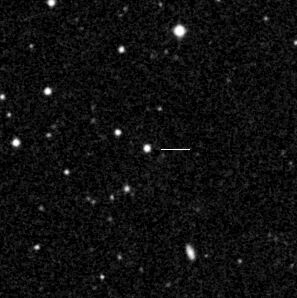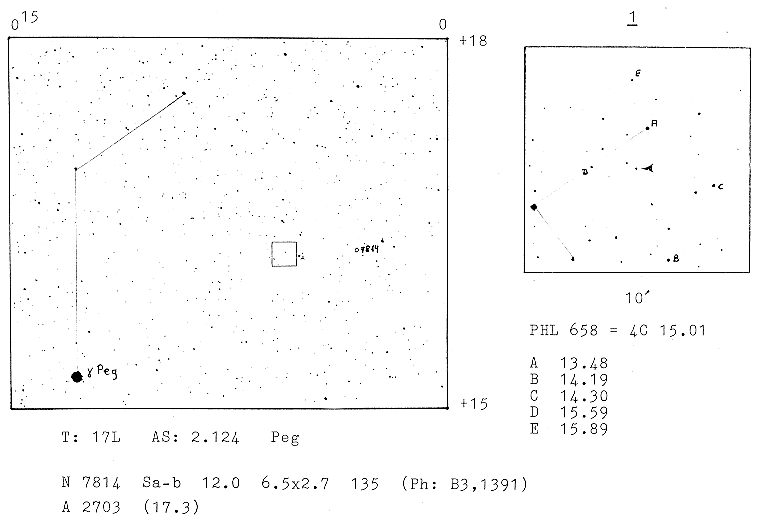

Catalogue of Bright Quasars and
BL Lacertae Objects
Wolfgang Steinicke
 |
 |
|
PHL 658 = KHQ 1
|
UM 186 = KHQ 222
|
Umkirch 1998
Preface to the new edition
14 years has passed since the last edition of the Catalogue of Bright Quasars and BL Lacertae Objects (the KHQ of 1984 is described in the following chapters 1 to 3). The number of known quasistellar objects has grown significantly. Also the definitions (e.g. based on absolute magnitude) has changed, and some KHQ-object were reclassified, e.g. as "Active Galactic Nuclei" (AGN) or Seyfert 1-galaxies. It is also interesting, that some BL Lacs are now interpreted as quasars.
But the "old" KHQ is not obsolete, because over the last years visual observing and CCD-imaging of quasars became a relevant field for amateurs, thanks to larger telescopes and better software. The catalogue is still very useful in selecting and finding these objects, there is, as far as I know, at present no comparable source for practical use.
For the new edition I added 23 missing finding charts and corrected some errors, but leaving the layout unchanged. A completely new catalogue is in progress, its database is already presented in the appendix. The list contains 454 quasistellar objects (north -20° declination, brighter than 16.5m). It is obvious, that, due to the growing number of objects, a graphically enhanced update is very time consuming, even with the aid of modern software.
Catalogue of Bright Quasars and BL Lacertae-Objects (ASCII-Data)
Some notes on the problem of "distance" (pdf in german).
1. Introduction
Presenting the sky to astronomical newcomers, you often hear the question "How far can we see with the telescope". You explain, that it does'nt make much sense, to tell something about the power of the telescope in this way. You cannot "see" distances through the telescope. The quality of the telescope is better described by its resolution and light collecting power.
The beginner is not impressed by remote, faint objects, but by spectacular views of the moon, planets or bright star clusters and nebulae. Distant galaxies are nice objects only through large apertures. Moreover one is misled by color photos. For the advanced observer small and dim images as gateways to the distant and past universe can be pretty exciting. Beside of the standard objects, galaxies and clusters of galaxies are a nearly unlimited observing potential.
Going this way, quasars are the culimation! In my own observing history I was led to quasistellar objects through the KDG, especially the galaxy pair NGC 4291 / NGC 4319 in Draco (KDG 126). In the Second Reference Catalogue of Bright Galaxies I red about NGC 4319's remarkable "companion", the quasar Mrk 205, which is located only 42" south of the normal galaxy. The 14.5m bright object should be seen in my C14. By the way the pair NGC 4319/Mrk 205 is the standard example of the redshift debate. The fact that the z-values are much different indicates, that there is no physical relation. But Arp will have found a "bridge of light", which would imply that the redshift is not cosmological. Anyway, Mrk 205 = KHQ 109 was an easy target in my telescope, and the first observation in 1983 was a really exciting moment. My "private" distance record was enlarged to 270 Mpc, three times the distance of the Coma cluster (the most remote entry in my KDG).
Are there even more quasars, which are in the reach of my C14? Sure, but beside of some bright objects (e.g. 3C 273 in Virgo) most of them are really a challenge. To a limiting magnitude of 16.5m there are more than 200. Some are variable and can reach a remarkable brightness in pretty short time.
2. Concept and definition of the Catalogue
The catalogue contains all known quasars and BL Lacertae objects brighter than 16.5m (at maximum if variable) and north of -20°. The redshift is limited by z > 0.040. The catalogue lists 222 objecte, which can be classified by their absolute magnitude, spectral or other features.
| quasars | Q | 155 |
| high luminosity quasars | HLQ | 12 |
| low luminosity quasars | LLQ | 29 |
| gravitational lenses | DQ, TQ | 2 |
| BL Lacertae objects | BL | 24 |
The main sources are:
The distance (which is defined by General Relativity) and absolute magnitude are calculated from z. For some BL Lac's with a featureless spectrum, there is no measured z-value. In the cases of the "Double Quasar" 0957+561 (KHQ 56) and the triple object PG 1115+080 (KHQ 81) the spectra are identical, which led to the interpretation of a gravitional lense. The "components" (images) are fainter than 16.5m, but the total magnitude is high enough to include these objects. Indeed, both objects were already observed!
3. How to observe quasars?
The following remarks are essential.
a) Instrumentation
To reach 16. magnitude you need an aperture of 14" or more. The objects are point sources, so a large focal length is neccessary to use a high magnitfication. But the field of view should not be too small, a wide angle ocular is useful. I prefer to observe without any additional equipment (e.g. a zenit prisma).
b) Finding method
I use star hopping in three steps, starting with a simple star chart (e.g. Tirion). For the second step I use the images from Vehrenberg's Atlas Stellarum, showing stars to 15 mag. Finally the finding chart is neccessary to identify the object.
c) Observation
Often faint starlike objects cannot be seen by direct viewing, they twinkle. Sometimes they are present, sometimes not (due to seeing conditions). In some cases it is possible to fix the object. Anyway, your eye must be adapted extremley well. Write down any success or failure and describe the observing conditions - but be honest to yourself!.
Example of a finding chart given in the printed version: KHQ 1 = PHL 658
